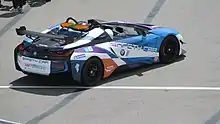Formula E
Formula E, officially the ABB FIA Formula E World Championship,[1] is a single-seater motorsport championship that uses only electric cars. The series is promoted and owned by Formula E Holdings. In 2011 it was conceived in Paris by Jean Todt at the FIA, and the inaugural championship commenced in Beijing in September 2014.[2] It is sanctioned by the FIA. Alejandro Agag is the founder and current chairman of Formula E Holdings.[3]
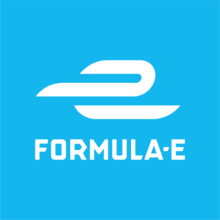 | |
| Category | Single-seater |
|---|---|
| Country | International |
| Inaugural season | 2014–15 |
| Drivers | 27 (2019–20) |
| Teams | 12 (2019–20) |
| Chassis suppliers | Spark-Dallara |
| Tyre suppliers | Michelin |
| Drivers' champion | |
| Teams' champion | |
| Official website | FIAFormulaE.com |
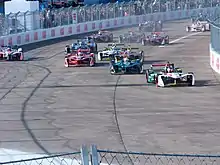
History
The proposal for a city-based, single-seater electric car motor racing championship was conceived by Jean Todt, the president of the world governing body of motorsport, the Fédération Internationale de l'Automobile (FIA), and presented to politicians Alejandro Agag and Antonio Tajani and the Italian actor Teo Teocoli at a dinner at a small Italian restaurant in the French capital Paris on 3 March 2011.[4][5][6] Tajani was concentrated on the electrification of the automobile industry, reducing carbon-dioxide emissions and introducing hybrid and electric systems. Agag supported Todt's proposal after the latter discussed the FIA opening up a tender to organise the series. Agag told Todt that he would take on the task because of his prior experience in negotiating contracts with television stations, sponsorship and marketing.[7]
The FIA announced in December 2019 that Formula E would be given world championship status from the 2020–21 season, making it the first single-seater racing series outside of Formula One to be given world championship status.[8]
Regulations
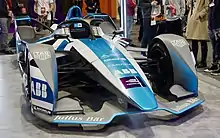
Overview
The Formula E championship is currently contested by twelve teams with two drivers each.[9] The sport features electric-powered race cars similar in style to the hybrid-drive cars of Formula One. Racing generally takes place on temporary city-centre street circuits, 1.9 to 3.4 km (1.2 to 2.1 mi) long.[10]
Race day format
All events begin with two practice sessions in the morning: an opening 45-minute session followed by a further 30-minute session. During these sessions, the drivers are free to use the full qualifying power output (currently 250 kW (335 bhp).[11]
The qualifying session takes place later in the day and lasts approximately one hour. The drivers are divided into four groups of six, with each group having 6 minutes to set their best lap. The first group consists of the six drivers currently leading the championship, followed by the next six in the championship etc. This is intended as a small handicap for the top drivers, because track conditions generally improve in the course of a session. Full power of 250 kW is available throughout qualifying. Since the second season, the six fastest drivers then go out again, one by one, in the Super Pole shoot-out to determine the top six grid positions.[12]
The race itself is set to 45 minutes plus one lap. During the first four seasons, drivers made one mandatory pit stop to change cars. With the introduction of the Gen2 car, this is no longer necessary, because the battery lasts for the full race. Since the all-weather tyres are designed to last for a whole race, pit stops are currently only needed to change a flat tyre or to perform repairs on the car. In race mode the maximum power is currently restricted to 200 kW (268 bhp).
Point scoring
Points are awarded to the top ten drivers using the standard FIA system (25-18-15-12-10-8-6-4-2-1). The driver securing the pole position is also awarded 3 points, while the driver setting the fastest lap (if they finish in the top ten) additionally receives 1 point (2 points during the first two seasons). The championship consists of both a drivers' and teams' championship. A driver's end of season total is made up of a driver's best results. A team's total is made up by counting both drivers' scores throughout the season.[12]
Fanboost
For each race, fans can vote for their favorite driver via various social media channels to give them an extra power boost. Voting starts 6 days before the event and closes after the opening 15 minutes of the race. The five winning Fanboost drivers each receive an extra power burst that can be used in a 5-second window during the second half of the race.[12]
Attack mode
With the fifth season, a feature called attack mode was introduced, in which drivers receive an additional 25 kW of power by driving through a designated area of the circuit off the racing line. The duration of the boost mode and the number of boosts available are decided only shortly in advance of each race by the FIA to stop teams from anticipating its use and incorporating it into race strategy.[13] All attack modes must be activated at the end of the race, but do not need to be used up (i.e. if a final attack mode is activated in the penultimate lap, the driver is not penalized for having it still activated at the end of the race). Starting season 6, the additional power has been increased to 35 kW.[14] If there is a full course yellow period or a safety car, attack mode will not be allowed to be activated. Under safety car or FCY, 1 kWh of energy will be knocked off, giving drivers and teams more energy management tactics.
Car
Spark-Renault SRT_01E
_at_2017_Berlin_ePrix.jpg.webp)
For the first four seasons, an electric racing car built by Spark Racing Technology, called the Spark-Renault SRT 01E, was used. The chassis was designed by Dallara, a battery system was created by Williams Advanced Engineering and a Hewland five-speed gearbox was used. Michelin was the official tyre supplier.[15][16][17] For the first season, 42 electric cars were ordered by the series. 4 cars were made available to each of the 10 teams and 2 cars were kept for testing purposes.[18]
This first Formula E car had a power of at least 250 horsepower (190 kW). The car was able to accelerate from 0 to 100 km/h (0 to 62 mph) in 3 seconds, with a maximum speed of 225 km/h (140 mph).[19] The generators used to re-charge the batteries are powered by glycerine, a by-product of bio-diesel production.[20]
In the first season, all teams used an electric motor developed by McLaren (the same as that used in its P1 supercar). But since the second season, powertrain manufacturers could build their own electric motor, inverter, gearbox and cooling system; the chassis and battery stayed the same. There were nine manufacturers creating powertrains for the 2016–17 season: ABT Schaeffler, Andretti Technologies, DS-Virgin, Jaguar, Mahindra, NextEV TCR, Penske, Renault, and Venturi.[21]
Spark SRT05e ("Gen2 car")
.jpg.webp)
The second-generation ("Gen2") Formula E car was introduced in the 2018–19 season and features significant technological advances over the previous Spark-Renault SRT 01E car – its 54 kWh battery and power output rising from 200 kW to 250 kW and top speed rising to around 280 km/h (174 mph). The arrival of the Gen2 car also sees an end to the series’ mid-race car-swaps.[22] The new cars are equipped with Brembo braking systems, chosen by Spark Racing Technology as the sole supplier.[23][24] The new cars are also equipped with the halo, a T-shaped safety cage designed to protect the driver's head in crashes and by deflecting flying objects.[25] Michelin remains as tyre manufacturer, supplying all-weather treaded tyres.[26]
Gen3 car (from 2022)
The Gen3 Formula E car is planned to be introduced for the ninth Formula E season (2022–23). Power levels for the car are expected to be 350 kW in qualifying and 300 kW in the race, while regeneration levels will be allowed on both front (250 kW) and rear (350 kW) axles for a maximum of 600 kW recovery under braking. The battery will also be designed to be able to handle "flash-charging" at rates of up to 800 kW, allowing pitstop recharging into the championship for the first time.[27] In July 2020 it was announced that Spark Racing Technology would build the chassis and supply the front axle MGU, Williams Advanced Engineering would supply the battery, and Hankook would supply all-weather tires incorporating bio-material and sustainable rubber.[28]
Seasons
Champions
2014–15
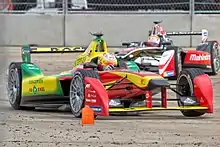
The calendar consisted of 11 races held in 10 different host cities: Beijing, Putrajaya, Punta del Este, Buenos Aires, Long Beach, Miami, Monte Carlo, Berlin, Moscow and finally London, where last two rounds of the championship took place.
The first Formula E race at the Beijing Olympic Green Circuit on 13 September 2014 was won by Lucas Di Grassi, after Nick Heidfeld and Nicolas Prost crashed out on the final corner. In the course of the season, there were 7 different race winners: Sébastien Buemi (three times), Sam Bird (twice), Nelson Piquet Jr. (twice), António Félix da Costa, Nicolas Prost, Jérôme d'Ambrosio and Lucas Di Grassi. The championship was decided with the last race in London, where Nelson Piquet Jr. became the first Formula E champion, only a single point ahead of Sébastien Buemi. Piquet, Buemi, and Di Grassi all had a theoretical chance at winning the title in the final round. The team championship was decided on the second to last race, with e.dams Renault (232 points) winning ahead of Dragon Racing (171 points) who surpassed ABT in the final round of the championship.
2015–16
The second season of Formula E started in October 2015 and ended in early July 2016. The calendar consisted of 10 races in 9 different cities. For this season eight manufacturers were introduced, who were allowed to develop new powertrains. Sébastien Buemi won the championship with only 2 points more than Lucas di Grassi by claiming the fastest lap in the final race in London.
2016–17
The 2016–17 FIA Formula E season was the third season of the FIA Formula E championship. It started in October 2016 in Hong Kong and ended in July 2017 in Montreal. Lucas di Grassi won the championship in the last race of the season, 24 points ahead of Sébastien Buemi and 54 points ahead of third-placed rookie driver Felix Rosenqvist. The Renault e.Dams team successfully defended their team championship title.
2017–18
The 2017–18 FIA Formula E season was the fourth season of the FIA Formula E championship. It started in December 2017 in Hong Kong and ended in July 2018. Jean-Éric Vergne clinched the title with a race to spare in New York by finishing fifth while title rival Sam Bird failed to score enough points to keep the fight going into the final race of the season.[30]
After a difficult first half of the season, Audi Sport ABT Schaeffler improved in the second half and passed Techeetah at the final race to claim the teams' championship by two points.[31]
2018–19
.jpg.webp)
The Gen2 race car was introduced for season five with significantly improved power and range, thus eliminating the need to change cars and pit stops altogether except for damages. However, cars are still vulnerable to power exhaustions if red flags and safety cars lengthen races. Gen2 also saw the introduction of the halo driver protection system.[32] The car was unveiled in January 2018.[33]
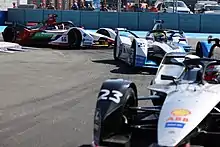
BMW, Nissan and DS Automobiles would join Formula E as official manufacturers for the 2018–19 season, with Nissan replacing Renault, which had exited the championship to focus its resources on its Formula 1 team.[34] The format of the races also changed from a set number of laps to 45 minutes plus one lap.[35]
The 2019 Hong Kong ePrix was the 50th race of Formula E since its inception in 2014. Formula E raced in 20 cities, across five continents, seen 13 global manufactures commit to the series. Four drivers have started all 50 Formula E races: Lucas di Grassi, Sam Bird, Daniel Abt and Jérôme d'Ambrosio.[36]
After the first race in New York City, Jean-Eric Vergne won his second Formula E championship, becoming the first driver to win more than 1 championship title, and a back-to-back championship title.[37] Techeetah won their first constructor's championship.[38]
2019–20
For the sixth season of Formula E, two more manufacturers joined the series: Mercedes-Benz and Porsche.[39][40] A number of rule changes were introduced to the championship, most notably the deduction of usable energy under safety car and Full Course Yellow conditions, with drivers having energy subtracted at 1kWh per minute.[41] Due to the COVID-19 pandemic the championship was suspended in March 2020 and all scheduled races were eventually cancelled.[42] The season was completed in August with six races at the Tempelhof Airport Street Circuit in Berlin on three different layouts.[43]
The season's champion was António Félix da Costa who clinched his first title with two races left. DS Techeetah became team champions for the second time in a row.[44]
2020–21
Starting with the 2020–21 season, the Formula E Championship will be granted FIA World Championship status, due to it having met the criteria of having four manufacturer competitors and races on three continents since the 2015–16 season.[45] The facelift of the Spark Gen2 car called the Gen2 EVO, was originally scheduled to debut in this season, but was later delayed due to the COVID-19 pandemic.[46]
In late 2020, Audi and BMW announced their withdrawal from Formula E after the 2020–21 season.[47]
Support series
FE School Series
During the first season, the FE School Series for student teams that developed their own electric car took place as support races at selected events.[48] The series was not continued during the second season.[49]
Roborace
Roborace is developing the world's first autonomous and electrically powered racing car.[50] The company is planning to develop the first global championship for driverless cars.[51] It held demonstrations at selected races during the 2016–17 Formula E season and 2017–18 Formula E season.
Jaguar I-Pace eTrophy
Formula E and Jaguar ran a production-based support series with Jaguar I-Pace battery electric SUVs.[52] The series was called the I-Pace eTrophy and ran together with Formula E's fifth and sixth seasons (December 2018 to summer 2020). In May 2020, Jaguar announced the cancellation of the series.[53]
Media
Television
Formula E provides comprehensive live television coverage shown via major broadcasters around the globe (FOX Sports, BBC, CCTV-5, Eurosport, Canal+, J Sports, Ziggo Sport Totaal[54]).[55][56] Production is carried out by Aurora Media Worldwide.[57]
Since the first season, the world feed is presented by Jack Nicholls and Dario Franchitti, with Nicki Shields acting as pit lane reporter.[58]
Documentary
Directors Fisher Stevens and Malcolm Venville created a documentary movie about the 2017–18 season called And We Go Green. It highlights some of the innovations and challenges of Formula E and follows several drivers and rivalries throughout the season. The film was co-produced by Leonardo di Caprio and premiered at the 2019 Toronto International Film Festival.[59]
References
- "The ABB FIA Formula E World Championship Kicks off with Three Days of Testing in Valencia". fia.com. 27 November 2020.
- Telegraph Sport (13 September 2014). "Formula E opens with spectacular crash involving Nick Heidfeld and Nicolas Prost as Lucas di Grassi claims win". Daily Telegraph. Retrieved 13 September 2014.
- "Championship Overview". fiaformula.com. Archived from the original on 31 May 2018. Retrieved 1 June 2018.
- Carp, Sam (2 February 2018). "Electrified: Alejandro Agag on Formula E's path to the podium". SportsPro. Retrieved 9 March 2018.
- Sam, Mallinson (13 April 2017). "From Dream to Reality: Formula E was born in Paris". FIA Formula E Championship. Retrieved 9 March 2018.
- Chowdhury, Saj (10 September 2014). "Formula E: Does it have a future in a world dominated by F1?". BBC Sport. Retrieved 9 March 2018.
- Kingham, Ben (13 May 2016). "On the subject of Power". Current E. pp. 40–59. Archived from the original on 15 July 2019. Retrieved 9 March 2018.
- "Formula E to be given world championship status for 2020–21". BBC. 3 December 2019.
- "Teams and Drivers". Formula E. Retrieved 23 December 2018.
- "FIA Formula E Championship circuit maps". Formula-e.org. Retrieved 23 December 2018.
- "Formula E presents Gen2 car for 2018/19 season". www.motorsport.com. Motorsport.com. 6 March 2018.
- "Rules and Regulations". fiaformulae.com. Retrieved 30 August 2020.
- Herrero, Daniel (8 June 2018). "Formula E confirms details of unique boost mode". Speedcafe.com. Retrieved 12 August 2018.
- "Rules and Regulations". FIA Formula E. Retrieved 19 June 2020.
- "Michelin confirmed as official tyre supplier for FIA Formula E Championship". Formula E Operations. FIA Formula E Championship. 28 March 2013. Archived from the original on 5 April 2013.
- "Renault signs with Spark Racing Technology and Formula E Holdings as Technical Partner in the FIA Formula E Championship" (PDF). Formula E Operations. FIA Formula E Championship. 15 May 2013. Archived from the original (PDF) on 12 June 2013.
- "Williams partners with Spark Racing Technology to provide battery expertise for the FIA Formula E Championship". WilliamsF1.com. Williams F1. 11 June 2013. Archived from the original on 16 October 2014.
- "Formula E buys 42 electric racers for 2014 circuit". green.Autoblog.com. 18 November 2012.
- "Guide to – Car – Specifications". Archived from the original on 30 November 2015. Retrieved 24 November 2015.
- "Formula E power generation". Archived from the original on 12 February 2015.
- "FE–Ten teams entered for the third Formula E season". 1 July 2016.
- "Formula E presents Gen2 car for 2018/19 season". www.motorsport.com. Motorsport.com. 6 March 2018.
- "The New Tech Headache Formula E Teams Must Solve". InsideEvs. 21 October 2018.
- "Next generation Formula E Car breaks cover in Geneva". FiaFormulaE. 6 March 2018.
- Stewart, Jack (24 February 2018). "Formula 1's New 'Halos' Could Save Drivers' Heads—And Give Engineers Headaches". Retrieved 21 March 2019 – via www.wired.com.
- Alex Kalinauckas. "Formula E unveils its Gen2 car for 2018/19 season". Autosport. Retrieved 9 May 2019.
- "Formula E's Gen3 Regeneration Concept Agreed". the-race.com. the-race. 18 June 2020.
- "The FIA and Formula E Build Ever More Relevant Future". www.fia.com. FIA. 1 July 2020.
- "The BMW i8: From vision to icon, from bestseller to classic of the future" (Press release). Munich: BMW Group. 11 March 2020. Retrieved 11 June 2020.
- Grzelak, Antonia (14 July 2018). "Vergne crowned champion at Audi festival in New York". www.e-racing.net. Retrieved 14 July 2018.
- Grzelak, Antonia (15 July 2018). "Audi grabs the last title as Formula E's first chapter ends". www.e-racing.net. Retrieved 15 July 2018.
- Laurence Edmondson. "Formula E reveals next generation car with Halo". ESPN. Retrieved 7 February 2019.
- "Formula E unveils new 'Gen 2' car for Season 5". Crash. 30 January 2018. Retrieved 6 February 2018.
- "FIA confirms 11-team Formula E entry list for Season 5". crash.net. 28 August 2018.
- Alex Kalinauckas. "Formula E's 'Mario Kart' plan formalised for 2018/19 season by FIA". Autosport. Retrieved 7 February 2019.
- "Stat Attack: 10 things you didn't know about the race in Hong Kong". Formula E. 7 March 2019. Retrieved 9 March 2019.
- Jerry Perez. "Jean-Eric Vergne Clinches Formula E World Championship in New York City". The Drive. Retrieved 18 October 2019.
- "Da Costa joins championship-winning team DS Techeetah". Formula E. Retrieved 18 October 2019.
- "Mercedes-Benz to enter Formula E in Season 6 – Formula E". fiaformulae.com. Retrieved 24 July 2017.
- "Porsche set to compete in Formula E from Season 6 – Formula E". fiaformulae.com. Retrieved 28 July 2017.
- Soulsby, Chris. "Formula E: Formula E confirms 2019/20 season rule and regulation changes". Motorsport Week. Retrieved 3 December 2019.
- "Formula E and FIA take decision to temporarily suspend season". fiaformulae.com. 13 March 2020. Retrieved 13 March 2020.
- "FIA Formula E Returns to Racing with Six Races in a row in Berlin". fia.com. 17 June 2020. Retrieved 17 June 2020.
- "Da Costa crowned ABB FIA Formula E Champion and DS Techeetah seals Teams' title as Vergne wins Round 9". fiaformulae.com,date=2020-08-09.
- "Formula E receives FIA world championship status for 2020/21". www.motorsport.com. Retrieved 3 December 2019.
- "FE delays Gen2 Evo car as part of new cost saving measures". www.autosport.com.
- Gitlin, Jonathan M. (3 December 2020). "Audi and BMW to both leave Formula E—here's why that's OK". Ars Technica. Retrieved 3 December 2020.
- "Formula E's School Series begins in Buenos Aires". fiaformulae.com. 19 December 2014.
- "Exclusive: schools series axed". current-e.com. 5 October 2015.
- "Formula E & Kinetik announce driverless support series". fiaformulae.com. 27 November 2015.
- "Formula E is planning the first racing series for driverless cars". engadget.com. 28 November 2015.
- "FFormula E and Jaguar to launch support series". fiaformulae.com. 12 September 2017.
- "Jaguar Cancels I-PACE eTrophy". e-racing365.com. 18 May 2020.
- FIA Formula E. "Television". Archived from the original on 30 May 2014. Retrieved 9 June 2014.
- "Formula E goes free-to-air in China". Current E : Your guide to Formula E.
- FIA Formula E. "CANAL to televise Formula E live for three seasons – Official FIA Formula E Championship".
- "FIA Formula E Championship". fia.com. Archived from the original on 30 May 2014. Retrieved 9 June 2014.
- "Jack Nicholls: "I've come full circle"". fiaformulae.com. 2 January 2017.
- "'And We Go Green' Review: Start Your (Quiet) Engines". nytimes.com. 4 June 2020.
External links
| Wikimedia Commons has media related to FIA Formula E Championship. |
- Official website

- Formula E on Twitter

- And We Go Green on YouTube (Formula E Channel)
| Awards | ||
|---|---|---|
| Preceded by Nissan GT Academy |
Autosport Pioneering and Innovation Award 2014 |
Succeeded by McLaren Applied Technologies |
